Driven by Civic Goals, Sacramento Public Library Wins Jerry Kline Community Impact Prize
Sacramento Public Library enriches its community in a way that’s vital locally and imperative in today’s divided times. The winner of the inaugural Jerry Kline Community Impact Prize, developed in partnership with the Gerald M. Kline Family Foundation, exemplifies the singular power of the public library to be a fully integrated and critically valuable community asset.
By their nature, every public library in America is an essential community asset. The best of these are deeply embedded in their civic infrastructure, and have a fundamental role in achieving the goals of their town or region. They demonstrate deep, reciprocal engagement—not merely meeting users’ needs as library leaders perceive them but letting patrons drive the library they dream of.
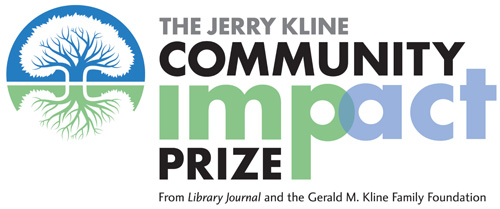 Sacramento Public Library (SPL) enriches its community in a way that’s vital locally and imperative in today’s divided times. The winner of the inaugural Jerry Kline Community Impact Prize, developed in partnership with the Gerald M. Kline Family Foundation, SPL exemplifies the singular power of the public library to be a fully integrated and critically valuable community asset. Like many strong library systems across the United States, it is aligning its mission with broader community goals and helping set them: embedding staff in other institutions; collaborating with other civic entities; and co-creating with individual members and subgroups of the service population. To achieve peak community impact, a winning library must help its people achieve peak community. SPL serves as a model for what’s possible when libraries break down barriers.
Sacramento Public Library (SPL) enriches its community in a way that’s vital locally and imperative in today’s divided times. The winner of the inaugural Jerry Kline Community Impact Prize, developed in partnership with the Gerald M. Kline Family Foundation, SPL exemplifies the singular power of the public library to be a fully integrated and critically valuable community asset. Like many strong library systems across the United States, it is aligning its mission with broader community goals and helping set them: embedding staff in other institutions; collaborating with other civic entities; and co-creating with individual members and subgroups of the service population. To achieve peak community impact, a winning library must help its people achieve peak community. SPL serves as a model for what’s possible when libraries break down barriers.
About the Award |
The road to success has not always been smooth. In 2008, SPL was the subject of a grand jury investigation and three people went to prison. In 2009, when Library Director Rivkah Sass (a 2002 Library Journal Mover & Shaker and 2006 Librarian of the Year) arrived, she and her team had to rebuild trust with stakeholders and constituents alike. To do so, they focused on engaging the community. That engagement, built over decades, has revitalized the library—and the community it serves.
GETTING PEOPLE INVOLVED
Goal one of SPL’s 2011 strategic plan was to increase positive public awareness, engagement, and ownership. It started with conversations—lots of them, with adults, kids, people with disabilities, and partner organizations. In 2015, the library repeated and broadened the process with than 2,000 conversations and online surveys, and included staff and stakeholders in face-to-face planning sessions.
Building on this strong foundation of engagement, SPL recently expanded its methodology, and began holding facilitated community conversations via the Richard Harwood method at all of its 28 locations.
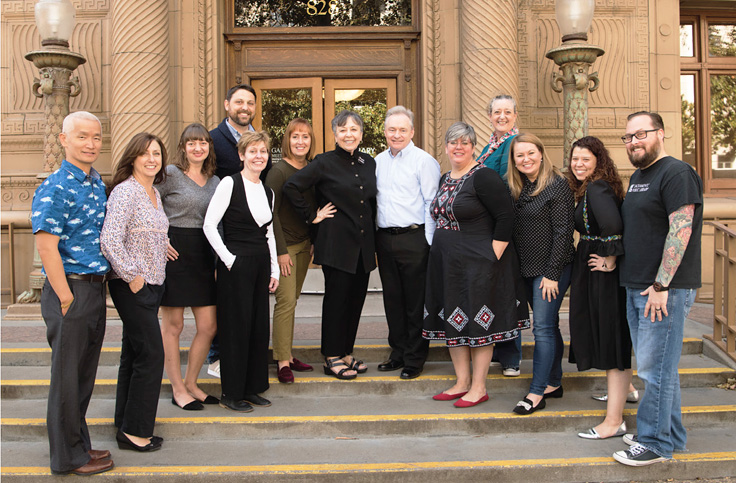 |
TEAM PLAYERS The power behind the community's library: SPL leadership team (l.-r.) Finance Manager Johnny Ea, Safety & Security Manager Karen Leland, Public Service Manager Madeline Walton-Hadlock, Human Resources Manager Christopher Trew, Facilities Manager Nina Biddle, Deputy Director Kathy Middleton, Director & CEO Rivkah Sass, Deputy Director Jarrid Keller, Youth Services Manager Christie Hamm, Community Engagement Manager Cathy Crosthwaite, Public Service Manager Ashley Trew, Public Service Manager Liana Acevedo, and Facilities Project Manager David Hillier. (Not pictured is Collection Services Manager Lisa Dale). Photo ©2019 Beth Baugher, True Love Photo |
One concrete outcome from these communications is SPL’s AccessABILITY team, created in 2017 and led by the late Amber Clark, who was posthumously named an LJ Mover & Shaker. As a direct response to conversations with patrons with disabilities and their families, the library developed an app and provides “We Speak Library” tablets to help non-verbal patrons use pictures to access services. Staff also implemented a Library Insiders program with weekly activities for adults and teens with developmental disabilities, and created visual tours of each branch to help prepare patrons for visits. SPL then created seven AccessABILITY HUB libraries that provide knowledgeable accessibility staff and additional programs and services for all ages. They have specialized staff training and prioritize the hiring of staff, interns, and volunteers with disabilities.
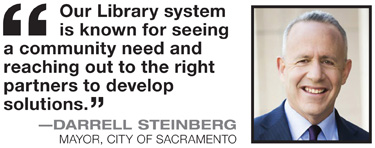 SPL also learned that users wanted more hours and books. In response, in 2018 and 2019, despite its relatively lean budget of about $33 per capita, SPL managed to add more than 169 hours across locations, bringing the total open hours to 1,069 per week, with six locations open seven days, five open six days, and 17 open five.
SPL also learned that users wanted more hours and books. In response, in 2018 and 2019, despite its relatively lean budget of about $33 per capita, SPL managed to add more than 169 hours across locations, bringing the total open hours to 1,069 per week, with six locations open seven days, five open six days, and 17 open five.
SPL eliminated fines on materials for children and teens, provided special-access library cards for teachers, and issued transitional cards to people without permanent addresses. In 2018, the library studied funding, circulation, and distribution data on world-language collections. It has since bought 15,000 new materials and redistributed its existing collection to align with neighborhood populations.
These efforts are ongoing: “Rich Harwood was here just last month,” Sass told LJ in October. “We had a couple hundred people show up. We invited 45 key community leaders to do a small group exercise with him, but 90 people came because they were so excited.”
To take these conversations to the next level, local NPR affiliate Capital Public Radio recently approached the library about teaming up.
AT THE CENTER OF JOINT PROJECTS
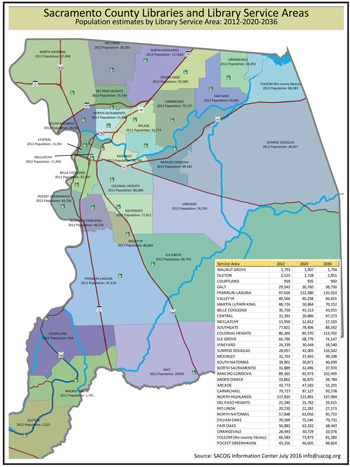 Beyond individuals, SPL prioritizes aligning with civic goals. An unusually structured system, SPL is governed by a joint powers authority board that comprises city and county elected officials from each of the seven jurisdictions the library serves—not only the urban California capital, but suburban and rural areas across nearly 1,000 square miles. The library’s service population reaches nearly 1.5 million.
Beyond individuals, SPL prioritizes aligning with civic goals. An unusually structured system, SPL is governed by a joint powers authority board that comprises city and county elected officials from each of the seven jurisdictions the library serves—not only the urban California capital, but suburban and rural areas across nearly 1,000 square miles. The library’s service population reaches nearly 1.5 million.
Sass credits this structure with promoting cross-pollination between these disparate constituencies, their representatives, and the library. “They all have to get along and we’re the Lazy Susan that connects them,” Sass explains. “That kind of engagement is built in. We meet face to face almost every month; it helps them understand and get what we do.”
“Our library system is known for seeing a community need and reaching out to the right partners to develop solutions,” attests Darrell Steinberg, Sacramento mayor. “This has generated a variety of creative and inclusive projects.”
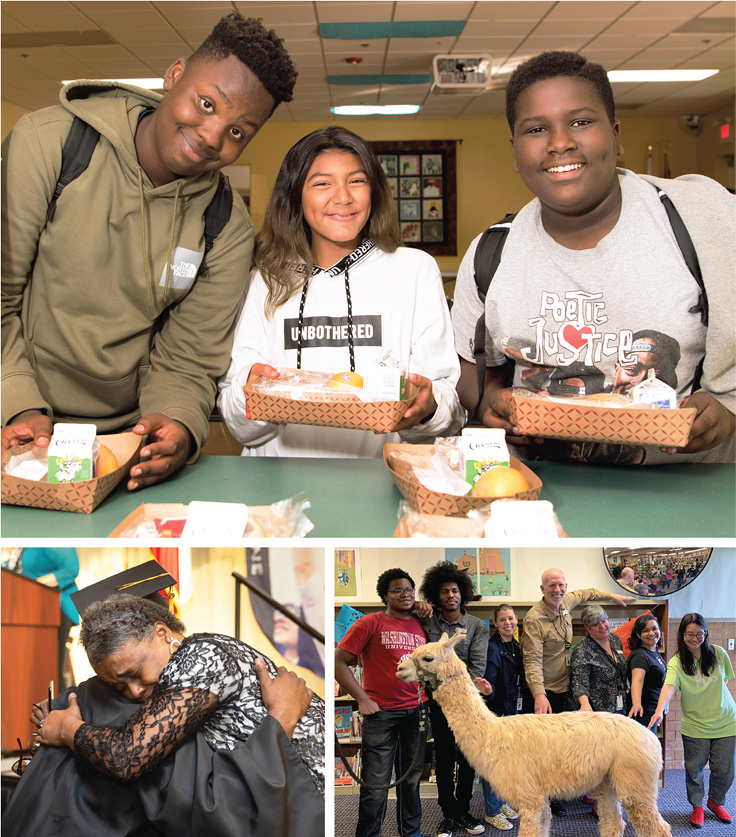 |
A WHOLE LLAMA LOVE FOR THE LIBRARY Top row: Meals at the Libary, where children ages 0–18 can get an afterschool meal for free with no questions asked, at the Belle Cooledge Branch. Bottom row, l.-r.: A family member embraces a graduate during the 2019 Career Online High School graduation at Central Library; Library staff and volunteers celebrate Día de los Niños with live storybook characters at Martin Luther King, Jr. Library, part of SPL’s extensive bilingual programming offerings. Top photo ©2019 Beth Baugher, True Love Photo. bottom photos courtesy of Sacramento Public Library |
For instance, youth workforce development is a high priority, particularly in underserved areas. SPL obtained funding for teen coordinators to help run the summer Lunch @ the Library program in 13 locations. When the City of Sacramento created its Thousand Strong initiative to provide work opportunities for teens, the library established paid summer internships. Teens from both groups have been hired in staff positions. To fill the gap created by a lack of local school librarians, the library hired a K-12 specialist, who serves the 14 school districts in Sacramento County that have limited or no professional library/media staff. Thanks to her work, 132,000 students in four school districts now have access to library materials via student IDs.
Partnerships with community organizations and other civic entities are essential. SPL partners with the Sacramento County Elections Department so its branches can serve as ballot drop-off sites or voter service centers, and teams with the Project for an Informed Electorate and the League of Women Voters to present annual explainer events for voters. This effectiveness in improving the voting experience led to a seat at the table for 2020 Census preparation.
Those partnerships expand the library’s reach and span age groups: SPL’s early learning specialist works with parent groups, preschools, community based organizations, and more, while the community engagement manager partners with shelters and affordable housing complexes to offer walk-in browsing. A new service launched this year provides underserved communities with technology services, Wi-Fi hot-spots, and family programming. Other partnerships pair the library with local theater, symphony, and dance companies; the Sacramento Municipal Utility District; summer camps and schools; the City of Sacramento Aquatics Department; and the Sacramento County Youth Detention Facility. SPL took the state-sponsored Veterans Connect @ the Library program’s stationary resource centers and developed pop-up versions to reach more veterans in the community.
As its relationships have built trust, the library has been approached to spearhead other community projects. A councilmember recently proposed a partnership with regional transit, which would provide free passes for K–12 students. The 22 library sites within the transit network’s service area were among the places kids can walk in and get their passes, because, as Sass says, “I had a board member who knew that we would do it—and do it well.”
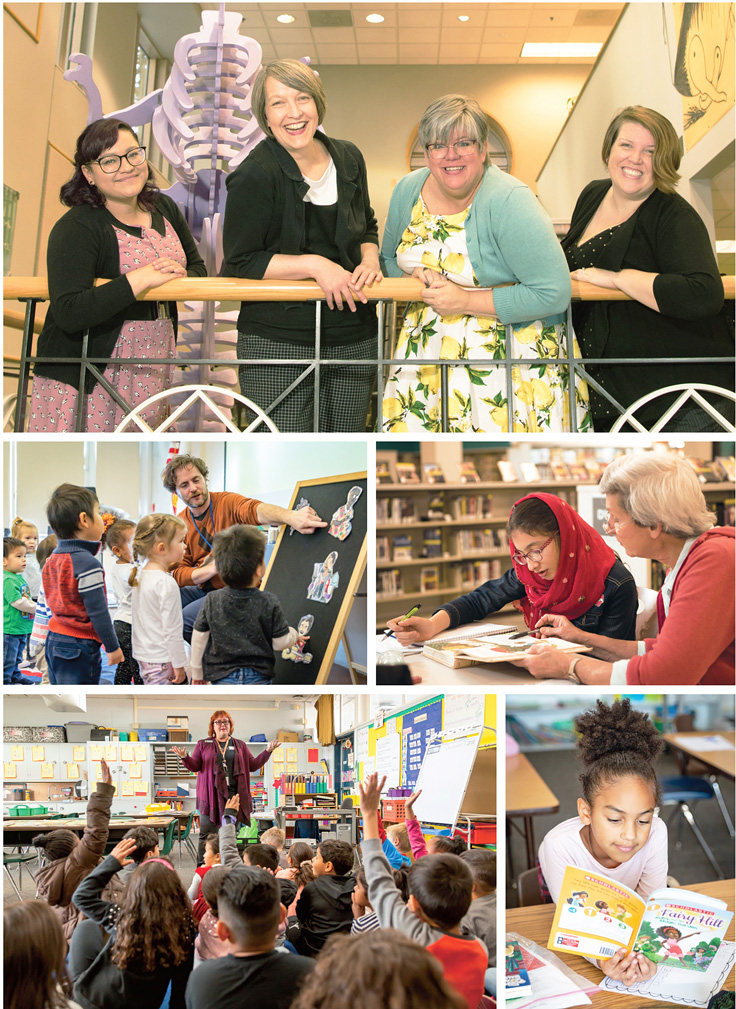 |
LAUNCHING YOUNG READERS Through partnerships, philanthropic giving, and digital inclusion, SPL helps kids find their love of stories, tell new ones, and start personal libraries. Top row: the Youth Services team, l.-r.: Librarian Adilene Rogers, Early Learning Specialist Donna Zick, Youth Services Manager Christie Hamm, and K–12 Specialist Amanda Foulk. Middle row, l.-r.: Toddlers at storytime with Librarian Nathan Milos at Valley Hi–North Laguna Library; Homework help is offered in multiple langagues; Bottom row: Librarian Kathy Chain visits a local first-grade class as part of The Book First initiative, to talk about the library and gift each child with a book of their choosing. Top and middle right photo ©2019 Beth Baugher, True Love Photo; all other photos courtesy of Sacramento Public Library |
Similarly, the library jumped in to help the city meet its goal of supporting early learning, identifying an Early Learning Nation grant opportunity and volunteering to write the proposal. Now the library leads the initiative. “It would not have happened if we hadn’t stepped up,” says Sass.
Local leaders appreciate that proactive spirit. SPL “truly supports building a strong foundation through early learning and its interactive and engaging programming that has been developed with the community in mind,” enthuses Natalie Woods Andrews, executive director, early learning, of the Sacramento County Office of Education.
Because the youth services manager serves on education impact task forces, SPL was recently empowered to serve supper to kids at the library. Staff focused on adult literacy paved the way for scholarships for older students to get high school diplomas through Career Online High School at the library. The Friends-funded BookFirst program, which gives two-thirds of first graders their first book, also deepens the library’s partnership with schools. “It’s much easier to get in to do visits and book talks than it was before,” Sass says. “We’re reaching more grades and schools than we were before we started the fundraiser.”
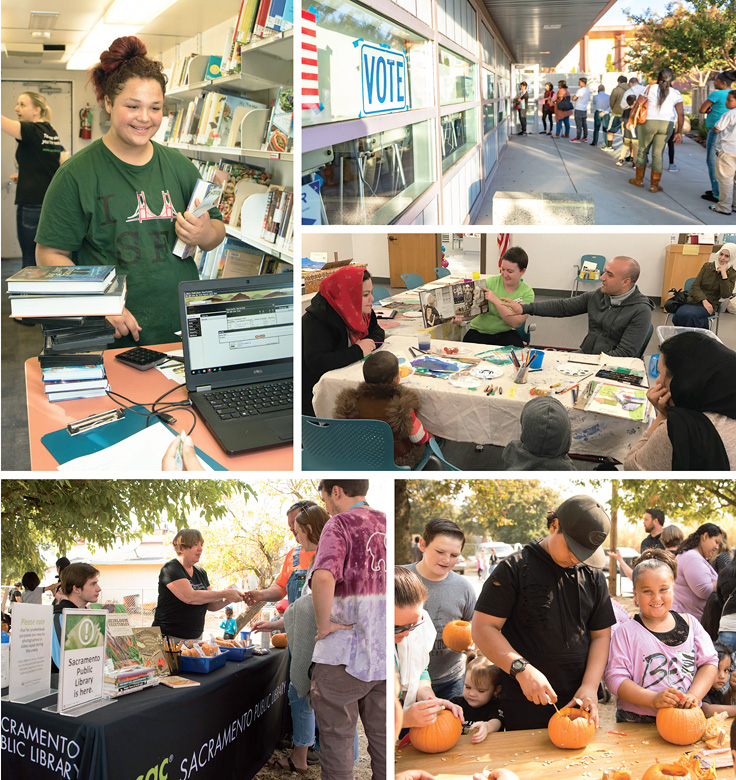 |
COMMUNITY CONNECTION SPL reaches into every corner of its community. Top left: checking out books during a mobile outreach visit to the Saybrook Apartments, which provides housing and support services to homeless families; SPL makes regular stops to Saybrook and provides tech-related library services, multilingual books, and STEM kits. Top right: In partnership with the Elections Department, SPL serves as a ballot dropoff and voter service center; Middle right: literacy programming for new families at the Arcade Library; staff also conduct outreach at apartment dwellings and community spaces to connect with immigrants who have recently moved to Sacramento. Bottom row: as part of green (and orange) outreach, Library Supervisor Sally McGrath (standing, l.) oversees a mobile seed library, plus pumpkin carving. Left and bottom row photos ©2019 Beth Baugher, True Love Photo; top right and middle right photos courtesy of Sacramento Public Library |
LOVING THE LIBRARY
975 SQUARE MILES AND 1.5 MILLION PEOPLE2,000 conversations and online surveys with adults, kids, people with disabilities, and partner orgs in 2015. 1,069 open hours per week: 6 locations open seven days, 5 open six days, and 17 open five since 2018. 15,000 new materials for world-language collections added since 2018. Right now 132,000 students can access library materials via student IDs. In one 24-hour fundraising event in 2019, more than $57,000 was raised to buy first-graders books. Currently more than 2,500 people volunteer 100,000+ hours of service annually. Summer Reading participation jumped 400 percent from 2009 to 2019; 22,335 patrons finished the program in 2018. All 300 staff members have attended an all-day training on implicit bias. Lunch @ the Library has provided 20,000 lunches at 13 branches in summertime. 1 vegetable garden, 6 seed libraries, and 2 community gardens are located at the Central Library. |
How do you assess what a library means to its community? Outcome measures are rare and often anecdotal: A kid becomes a passionate reader or an adult finds a better job.
But SPL sees powerful indicators that the community loves its library. More than half the residents in the service area have library cards. Philanthropic support is growing: More than $57,000—a 27 percent increase over 2018—was raised to purchase books for first graders on the Big Day of Giving, a 24-hour fundraising event. More than 2,500 people volunteer 100,000+ hours of service annually. Summer Reading participation has jumped 400 percent since 2009; 22,335 patrons finished the program in 2018.
The library and its staff have received a list of local awards, but the validation that means the most arrived at the ballot box: The community passed two library funding ballot measures, at 74 and 79 percent, in 2014 and 2016.
INTENTIONAL ABOUT INCLUSION
Inclusion is a cornerstone of SPL’s practice, and it starts with staff. The Equity, Diversity and Inclusion Team helps reach a broader range of applicants, and advocates for them after they’re hired. This increases the visibility and voice of SPL’s workforce and ensures support for discussions on equity, diversity, and inclusion at the library. All 300 staff members attended an all-day training on implicit bias. Task teams focused on languages, cultures, and diverse communities provide guidance, tools, and training for the rest of the staff.
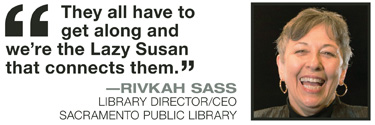 Just as important as these universal steps are targeted ones. Bilingual staff members offer culturally relevant programming and collections in the neighborhoods where they’re needed. For instance, the Arcade Library branch is located near where new arrivals from Afghanistan live. Branch staff partnered with a local resettlement organization, which led to a meet and greet; the addition of Dari/Farsi and Pashto materials; a grant-funded series of art-making events called “Immigrant Families Connect”; more library promotional materials translated into Dari/Farsi; paid teen summer interns fluent in Dari/Farsi; and visits from Afghan American authors Fariba Nawa and Tamim Ansary. The branch also added an ESL class that includes a weekly storytime, courtesy of a partnership with the local school district.
Just as important as these universal steps are targeted ones. Bilingual staff members offer culturally relevant programming and collections in the neighborhoods where they’re needed. For instance, the Arcade Library branch is located near where new arrivals from Afghanistan live. Branch staff partnered with a local resettlement organization, which led to a meet and greet; the addition of Dari/Farsi and Pashto materials; a grant-funded series of art-making events called “Immigrant Families Connect”; more library promotional materials translated into Dari/Farsi; paid teen summer interns fluent in Dari/Farsi; and visits from Afghan American authors Fariba Nawa and Tamim Ansary. The branch also added an ESL class that includes a weekly storytime, courtesy of a partnership with the local school district.
The Colonial Heights Library, in the City of Sacramento, offers programs centered on tribes indigenous to the area. The North Highlands-Antelope Library is the “Brighton Beach of Sacramento,” says Sass. Locals hail from Russia, Ukraine, and other Eastern European countries, and the branch holds a weekly Russian/English storytime.
At the Southgate Library, on the edge of South Sacramento, homework help is available in Vietnamese. A bilingual outreach librarian provides training and support to staff across the system, and bilingual outreach storytimes travel beyond SPL’s 28 locations to Birth and Beyond Centers, First Five Resource Centers, and the Mexican Consulate.
Other intentionally inclusive early learning programs include storytimes designed around the needs of children with sensory processing disorders, and LGBTQ+-friendly storytimes. The teen advisory board’s Harry Potter Yule ball has become a queer prom, the flagship offering in a rich selection of LBGTQA teen programming.
To address the needs of patrons living in poverty, Raising Readers offers library cards, parent workshops, storytimes, and access to materials in affordable housing. Lunch @ the Library provided more than 20,000 lunches at 13 branches, filling the gap left by school summer closures.
Digital inclusion, which started small with Libraries Illuminated, a gaming project in SPL’s most rural constituency, has since grown into a key area of focus, says Sass. The library convened a Digital Inclusion Summit of 40 agencies, including the Mayor’s Office of Education, and out of that came a digital inclusion plan for the whole region.
INVESTED IN LEADERSHIP DEVELOPMENT
SPL’s Yes! Customer Service model trains all of its 302 FTE staff to believe in and listen to the community and provide a welcoming environment. Staff are also trained on implicit bias, intellectual freedom, and de-escalation.
This broad-based approach provides a foundation for leaders to emerge from anywhere in the organization. More than a third of all supervisory and management positions recently filled are held by employees who have participated in SPL’s Leadership Development Program, which commits a 20-person cohort to 11 all-day sessions over a nine-month period. Program components include self-awareness, emotional intelligence, application of problem-solving methods, and communication tactics.
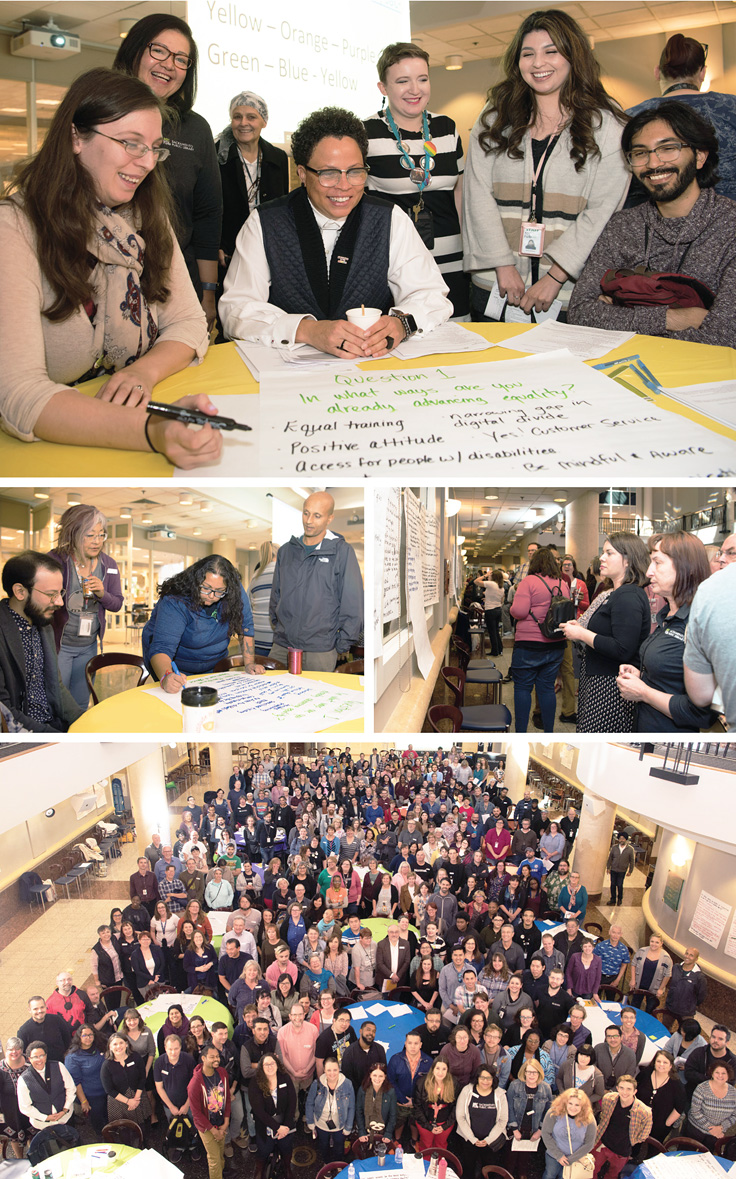 |
ON THE JOB All-staff inclusion training with City of Sacramento Diversity & Equity Manager Aimée Zenzel Barnes (top photo, seated, c.). Middle row: staff members rotated between colored tables to answer questions posted at each about overcoming bias in the library, and then reviewed the responses. Bottom row: SPL staff after a successful day of training. Photos ©2019 Beth Baugher, True Love Photo |
SPL also invests in tuition reimbursement for those identified for potential leadership roles, and offers the opportunity to participate on local, regional, and national boards and attend trainings and conferences.
“Leadership development is what I am most excited about,” says Sass. “My mantra is, let’s build [talent]. Let’s create opportunities for people to take on projects. Pretty much everything we do is built on a task team approach that lets people say ‘hey, what if we...?’” The Library Thinktank offers frontline staff the chance to be heard by management, share ideas, learn from experts, and develop self-confidence.
To identify who might be a potential leader, SPL invested in the CliftonStrengths individual assessment tool, developed by Gallup. To increase those skills, SPL’s nomination explains, the library “borrowed heavily from the British concept of the secondment, a temporary assignment that allows employees to learn a new skill, lead a project, or help determine if a new type of position is needed.”
SUSTAINABLE BY DESIGN
Sustainable thinking drives SPL not only in succession and fiscal planning, but in its directive to use green products for both minor infrastructure needs (such as LED lightbulbs) and large-scale initiatives, including the LEED certified Valley Hi-North Laguna Library. Sass tells LJ, “rather than building new buildings, we are advocating for our jurisdictions to reuse buildings and turn them into libraries.”
SPL provides biodegradable filament for its 3-D printers, stopped advertising on paper fliers, and conducts outreach in an all-electric bookmobile.
Changing behavior is key. Bike racks are located in front of every building, with bike locks available for checkout. One location even has a bike share station. An emphasis on virtual meetings and trainings saves fossil fuels, and carpooling is encouraged—as is taking public transit, via free or discounted passes. Partnering with the utility district led to solar robotics workshops and energy use meters for checkout.
Going green is embodied in the living wall in the Central Library’s Kid’s Place, the vegetable garden on the staff balcony, six seed libraries, and two community gardens. Sass even notes the lifecycle of a physical book: A title will circulate up to 100 times before it’s resold by the Friends, donated to a senior center or a nonprofit, placed in a Little Free Library, turned into an art installation, or recycled.
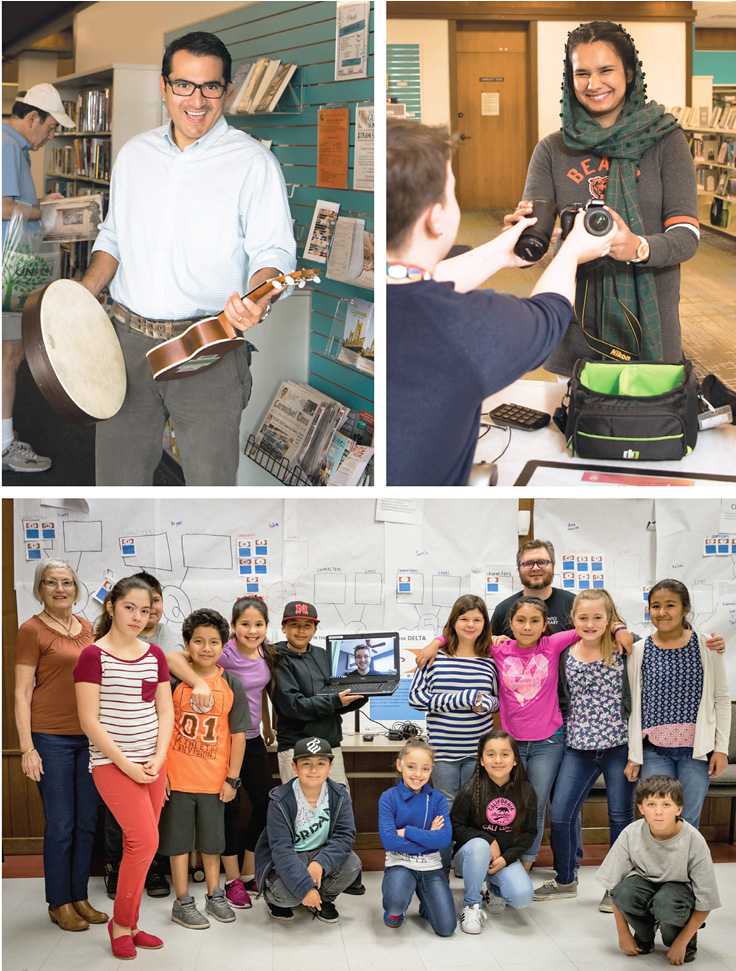 |
ALL THE THINGS SPL offered an early Library of Things, which has been replicated at libraries nationwide. Top row: Materials that can be checked out at the Arcade Library include musical instruments, sewing machines, lawn equipment, and more. Bottom row: Librarian Christopher Durr (standing, r.) and the rural fifth-grade class that designed a video game at Walnut Grove Library. Top photos ©2019 Beth Baugher, True Love Photo; bottom photo courtesy of Sacramento Public Library |
A CENTER OF INVENTION
SPL stands out for piloting innovative services. SPL pioneered an early Library of Things, enabling patrons to check out everything from GoPro cameras to a life-size human skeleton model. The I Street Press, using a print on demand machine, allows self-publishing by local authors and library-curated volumes such as one about Edgar Allan Poe that became the centerpiece of a community read campaign.
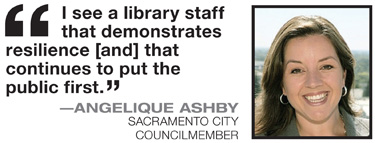 Serious fun is part of the plan. The alt+library initiative, recently rebranded as Library AF, connects to younger people through irreverent programming such as Punk Rock Aerobics, Bad Art Night, and book clubs held in coffee shops, pubs, and graveyards. Libraries Illuminated paired live-streaming of library programs with teaching teens new media skills such as configuring a network and operating production software and A/V equipment. Teens were challenged to turn the library’s archive of historic Sacramento blueprints and images into virtual objects in Minecraft. Game design and play testing were livestreamed so viewers could suggest improvements. The resulting board game was Kickstarted into production. Now in its third year, the Librarygame program leverages collaborative video game design to teach technology, project management, and storytelling skills to youth in schools.
Serious fun is part of the plan. The alt+library initiative, recently rebranded as Library AF, connects to younger people through irreverent programming such as Punk Rock Aerobics, Bad Art Night, and book clubs held in coffee shops, pubs, and graveyards. Libraries Illuminated paired live-streaming of library programs with teaching teens new media skills such as configuring a network and operating production software and A/V equipment. Teens were challenged to turn the library’s archive of historic Sacramento blueprints and images into virtual objects in Minecraft. Game design and play testing were livestreamed so viewers could suggest improvements. The resulting board game was Kickstarted into production. Now in its third year, the Librarygame program leverages collaborative video game design to teach technology, project management, and storytelling skills to youth in schools.
To ensure easy replicability and uniformly high standards across its system, SPL created Read Together kits and 120 boxed programs that can be easily reproduced. Many of SPL’s innovations are adaptable, and the team takes pains to make them available. As the second library in the United States to adopt Gale Cengage’s Career Online High School, SPL modified the program to make it more manageable for staff and students. The vendor adopted SPL’s protocols, which were integrated into training for new libraries. SPL has received a grant for training up to 1,700 California library staff on accessibility services. SPL also invites staff from neighboring libraries to attend training sessions offered by its youth services team.
TAKING ON BIG ISSUES
In March 2018, a young black Sacramento resident, Stephon Clark, was shot and killed by police in his grandmother’s backyard. In response to the incident and the resulting protests, SPL extended hours at the library in Clark’s neighborhood, provided community programming, offered free lunch, and helped people engage with one another. Stephon’s brother Stevante became a library advocate, and his work helped convince the City of Sacramento to renovate SPL’s Martin Luther King Jr. Library.
Later in 2018, SPL staff member Amber Clark (no relation) was murdered in the parking lot as she left the branch she managed. That tragedy might have fostered fearful pulling back. Instead, says Sacramento City Council and Public Library Authority Board member Angelique Ashby, “I see a library staff that demonstrates resilience [and] that continues to put the public first.”
The team channeled grief into developing new safety protocols and doubled down on the accessibility services Clark loved most. Amber’s widower, Kelly Clark, was recently hired by SPL to conduct a qualitative and quantitative analysis of the library’s community impact.
Whatever challenges the Sacramento region faces, the community—and its library—can be confident that they will tackle them together.
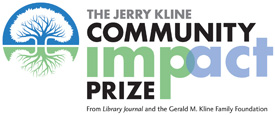 ABOUT THE JERRY KLINE COMMUNITY IMPACT PRIZE
ABOUT THE JERRY KLINE COMMUNITY IMPACT PRIZE
The Jerry Kline Community Impact Prize recognizes the public library as a vital community asset. The prize seeks to honor a library that has achieved this recognition to the highest degree through a strong reciprocal relationship with its civic stakeholders and community.
To honor its exemplary record, the Sacramento Public Library will be presented with $250,000 from the Gerald M. Kline Family Foundation at a gala celebration during the 2020 Public Library Association conference in Nashville.
We thank the following external judges who helped inform the final decision:
DEBORAH JACOBS former Director of the Bill & Melinda Gates Foundation’s Global Libraries initiative, former Seattle City Librarian, and LJ 1994 Librarian of the Year
ERIC KLINENBERG Helen Gould Shepard Professor of Social Science and Director of the Institute for Public Knowledge at New York University and author of Palaces for the People: How Social Infrastructure Can Help Fight Inequality, Polarization, and the Decline of Civic Life
MARC A. OTT Executive Director of the International City/County Management Association
Also serving as judges were: Leslie Straus, Library Grants Director, Gerald M. Kline Family Foundation; Rebecca T. Miller, Editorial Director, LJ; and Meredith Schwartz, Executive Editor, LJ.
For more information, see libraryjournal.com/communityimpact
RELATED
ALREADY A SUBSCRIBER? LOG IN
We are currently offering this content for free. Sign up now to activate your personal profile, where you can save articles for future viewing









Add Comment :-
Comment Policy:
Comment should not be empty !!!
Monica Barr
I have learned so much from the staff and resources made available through the Sacramento Public Library systemPosted : Oct 29, 2019 06:47
Monica Barr
My favorite part of Sacramento is the library system that really is a vital community asset and a home away from home.Posted : Oct 29, 2019 06:44